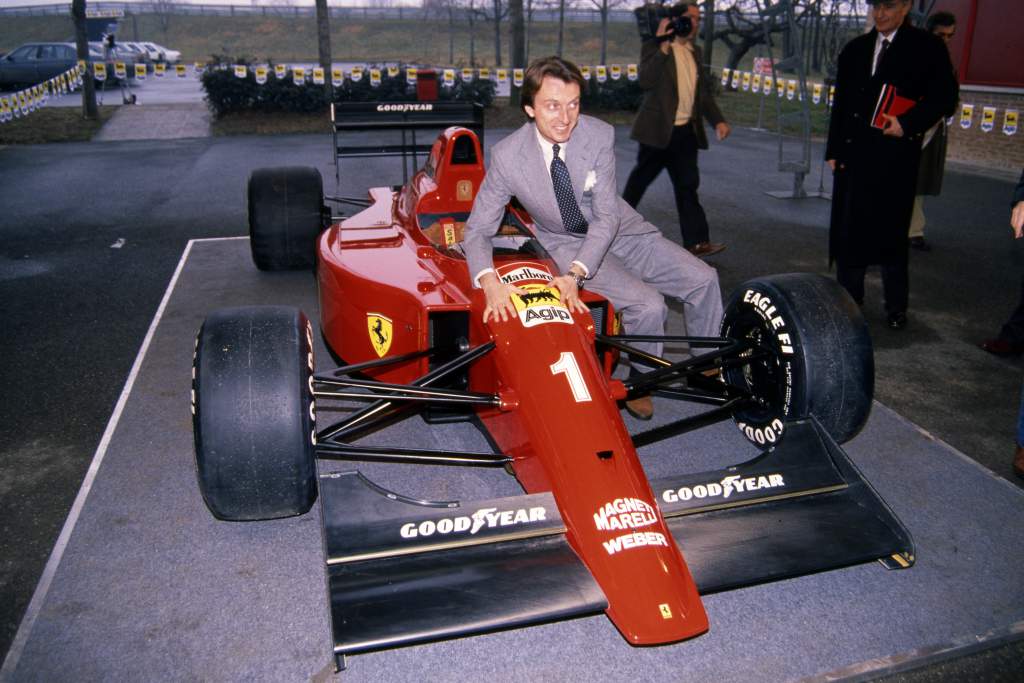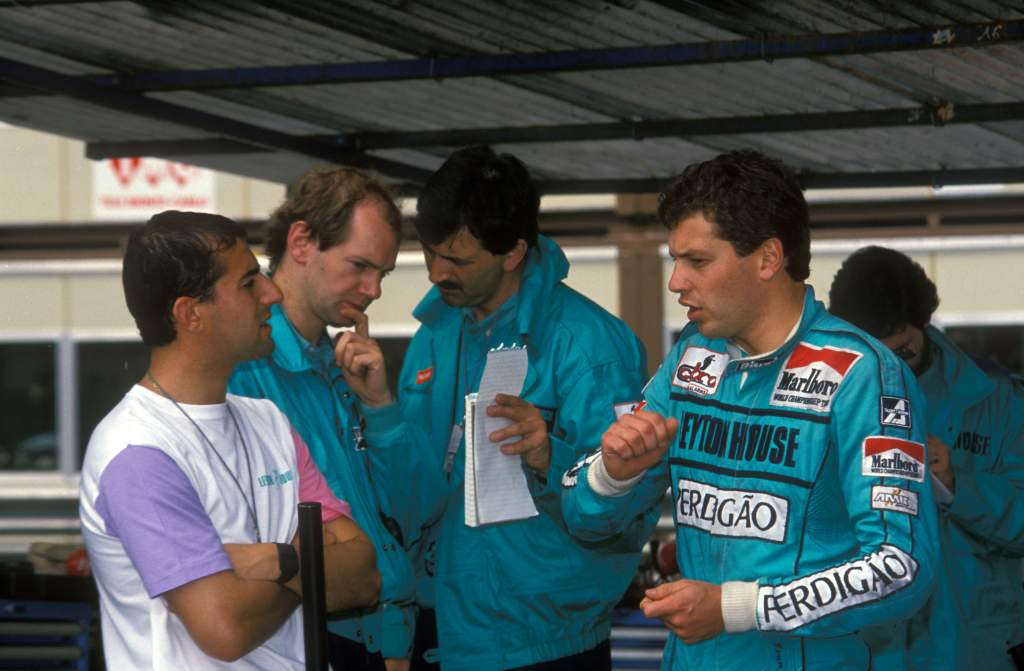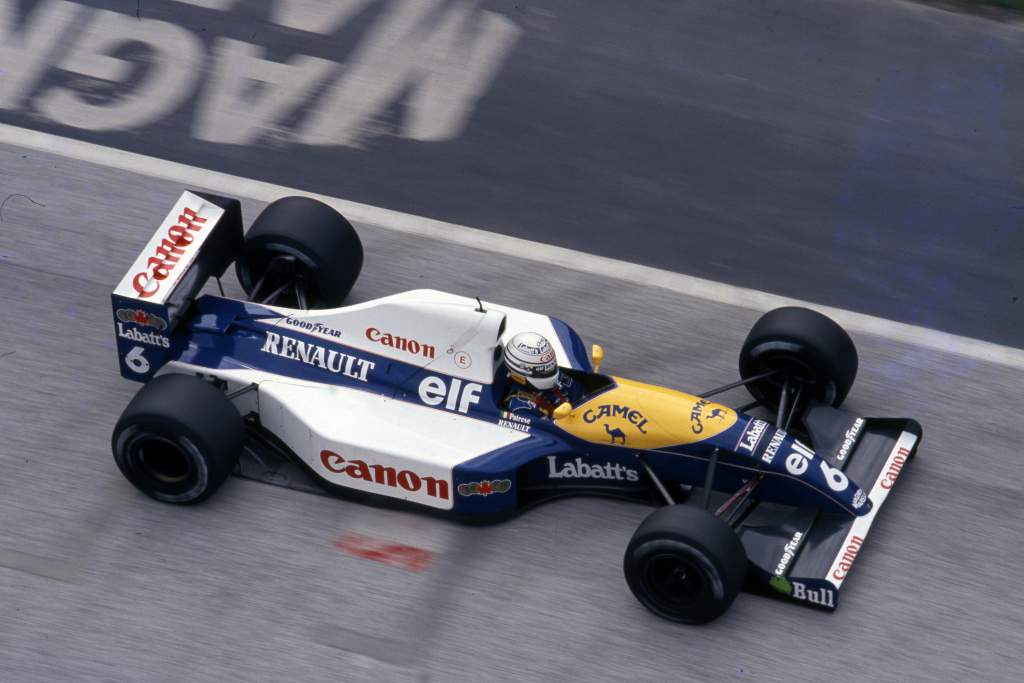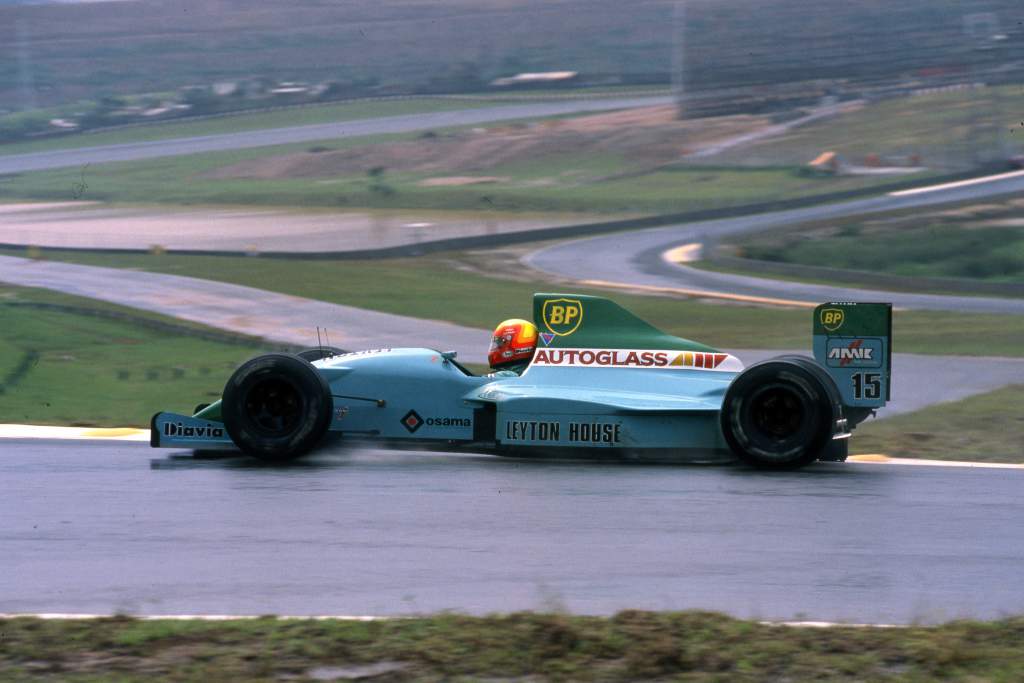There’s a strong case for saying that Monday July 9, the day after the 1990 French Grand Prix, was a formative day that shaped a great deal in F1 in the final decade of the 20th century.
Alain Prost had won the race, at a scorching and arid Paul Ricard for Ferrari. There was nothing too spectacular in that. But with context it was a tale of intricate complexity.
Ivan Capelli led for the majority of the race in a Leyton House CG901 that a fortnight before had failed to qualify for the Mexican Grand Prix. But the car had been transformed by new parts designed by Adrian Newey just before he departed the team – watching his car’s finest moment from the sofa at home. It illustrated an almost transcendental quality to how things unfolded the following day.
A few hours after Prost stood atop the podium at Paul Ricard, across the border in Rome, West Germany were beating Argentina in a tempestuous World Cup final as Italia 90 came to a close.
As the solid gold icon of soccer success was presented to West German captain, Lothar Matthäus, a few rows to the left of the joyous midfield legend sat Luca di Montezemelo, basking in the glow of a successful month which he had masterminded.
Between Newey and di Montezemelo there must have been the same question bouncing around their brains – what next?

While di Montezemelo would take a year to find his way back to Maranello as president where he would help rescue a chaotic and fitful Prancing Horse, Newey was already embarking on the short journey from Leyton House’s Bicester base to Didcot, the home of Williams.
But on the morning that Newey walked in to the Williams reception area, no one had mentioned it to the tiny R&D team.
Among them was Chris Saunders. He had been at the team working with the likes of Frank Dernie, Enrique Scalabroni and of course team co-owner, Patrick Head, since 1986.
“I walked into my office that Monday morning, and Adrian was sitting in my chair. Patrick told none of us he was coming,” recalls Saunders.
“I shared an office with Paddy [Lowe] and Steve Wise, who were heads of electronics and working on control engineering. Frank Dernie had brought them in a year after I joined the company.”
While Lowe’s career is well-known, Wise was head of electronics at the time and had designed the original Vehicle Control Module (VCM), which was the first-generation computer control system and contributed considerably to the active ride programme, which was already being tested in 1990 by Mark Blundell.
First impressions were a bit sketchy for Newey (pictured below at Leyton House), who was still hurting from not being able to be present at Paul Ricard the day before to see his creation turn the F1 paddock on its head.

“What I remember is suddenly this other guy, who I didn’t know, turning up and it was Adrian,” says Saunders.
“He introduced himself and I said, and I remember it to this day, ‘Oh, so you’re the escapee from Leyton House’.
“I actually don’t think that initially endeared myself to him, but I loved working with him from the start, and we became good friends.”
The summer of 1990 was significant for Williams. Not only because of the sea change in future investment via Newey but wheels were already in motion for a 50% scale windtunnel to be open and functioning in the summer of 1991.
The new facility was being built in the back yard of the Williams factory at Didcot, with Saunders project-managing it just as Newey arrived.
The plans went to another level within a few months of Newey joining Williams, as Geoff Willis was recruited.
But according to Saunders this was not through the commonly accepted route via his previous work with Newey after a brief period in early 1990 when he was a CFD consultant to Leyton House.
In fact, Willis and Saunders had been friends at the National Physical Laboratory (NPL) in the early 1980s when Saunders was involved in aero studies for McLaren under the direction of John Barnard and Alan Jenkins, while Willis was studying for a PHD in fluid dynamics via the NPL’s famed wind tunnels.
“Adrian knew Geoff through Leyton House anyway, but I said ‘why don’t we talk to him?’ because he was a person common to both of us, and very clever,” Saunders recalls.
“We had this shiny new tunnel, which Adrian certainly made the most of. It is not a coincidence we went and hammered everybody with the (FW) 14 and 14B, because the facility was brilliant from the start.

Saunders and the Williams team brought the tunnel online smoothly, after ironing out all the typical faults of such a new facility, and got good repeatability and flow quality in readiness for midway through the 1991 season.
Prior to this opening, Frank Williams had in fact funded three years at Southampton University’s R.J Mitchell tunnel, where Saunders and others would regularly drive to in a team van laden with kit and scale models.
Penske Cars owned the motion control strut and software at the Mitchell tunnel, which it used due to its close proximity to Poole, where the company was based.
Ironically, it was the smaller tunnel facility at Southampton University which was used by Leyton House in 1989 and 90 which was proven to have been giving Newey dodgy results and likely contributed to the disastrous CG891 of 1989 in which Capelli and teammate Mauricio Gugelmin had failed to score a point (Gugelmin’s podium in the season opener coming in the 1988 car).
Now though, Newey had a quality fully-functioning tunnel within walking distance of his drawing board and the results were explosive.
“It’s funny to think that the guy sat in my office chair turned out to be the person who was about to achieve so much” :: Chris Saunders
“Adrian kind of landed on his feet with the tunnel coming on-line at the back of the factory, but it was also clear from a very early stage that he was really good and had unbelievable flair,” says Saunders.
“He could sort of envisage where the air was going in his head, that is the only way I can describe it and I certainly hadn’t ever seen that before.
“He was prolific, reams and reams of paper just used to come off the drawing board at dizzying speed. It was amazing to see.”
Newey though was by no means perfect at that stage of his career but he knew exactly what he wanted even if it rubbed some up the wrong way.
“He did also upset a few people in the design office because guys like Brian O’Rourke [composites manager] originally thought he was a bit of a charlatan because he thought he wasn’t that knowledgeable on composites,” recalls Saunders.
“Brian was safe and conservative in terms of having precisely the right insert or layup, or whatever, and Adrian would just go ‘well that’s too heavy, so we’ll change it’.
It wasn’t long before Saunders also saw the now-famed Newey attention to detail in action.
“I mean, if you look at that car [the CG901], it had Mickey Mouse ‘ears’ [front-wing endplates],” he says.

“Those were an Adrian signature for sure, and at Williams I remember being in the windtunnel doing dozens of versions of those end-plates, and we also used to have a further 20 or so trim-lines on each of the development front wing endplates.
“There used to be ‘a notch’ on the footplate, which is where it used to generate the vortex that would shed off it. So, you’d be doing work on notch three of 22 at various angles and widths, it was bloody intense, but we could track the notch vortex in the windtunnel because the data it produced was that good and precise.
“You really could develop the car a pound at a time, whereas in a lot of facilities that other people were using, you could simply not resolve that level of detail from the data. “
Newey hit the ground running at Williams and as Saunders attests the resulting success of the race-winning FW14 and the subsequent 14B that took the team’s first title for five years.
What would become a seven-year epoch of triumph and tragedy at Williams was melded in a volatile period for Newey, in which he was forced to watch his latest creation revive itself in spectacular fashion on TV.
As Saunders attests, these were heady days but also ones driven by ambition.
“I don’t recall talking to him about the Leyton House really, but you could tell that it probably drove him quite a bit and the FW14 clearly took many cues from that car, especially the raised underside to the nose.
“It’s funny to think back now, 30 years later that the guy sat in my office chair turned out to be the person who was about to achieve so much and bring so much success.”




